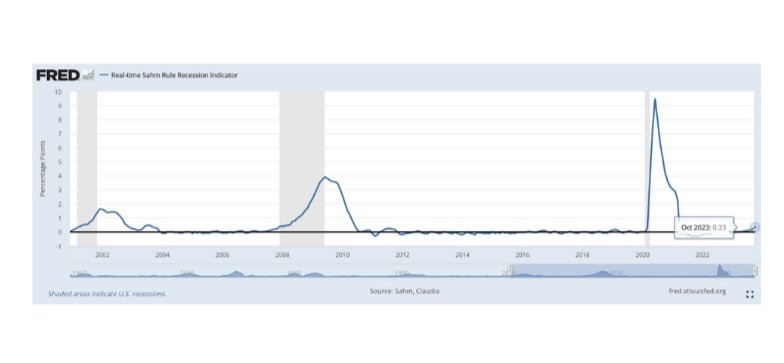The amazing metric that predicts every recession (and why designers should care)
Have you noticed the recent flurry of news about the US potentially heading into a recession? During these discussions, one concept gaining attention is Sahm's Rule – an economic indicator with a proven track record in predicting recessions.
Sahm's rule is like a financial storm alert. Developed by Claudia Sahm, a former economist at the Federal Reserve, it says that if the average unemployment rate in the last three months increases by just half a percentage point higher than the lowest point in the past 12 months, the economy might be heading into a recession.
Wait, what?
Let’s break it down with an example. So, if the lowest unemployment rate in the last 12 months was 5% and the average unemployment in the last three months was 5.5%, we are headed towards a recession.
This is a much faster way of predicting downturns compared to traditional methods, which often require a full year of data. Sahm’s rule has accurately identified every recession since 1960 without any false alarms. In the world of economic indicators, that's a pretty impressive track record.
Could it be right again? Currently, the indicator stands at 0.33 percentage points. According to The Economist, only a slight increase in the unemployment rate would push the US economy into a recession. Well, at least according to the Sahm’s rule.
Claudia Sahm, however, didn't develop the formula for Wall Street analysts or market traders. Her aim was more altruistic. She envisioned it to trigger quick financial aid to people during economic downturns. Talk about a design with purpose!
How Recessions Change Economies
Understanding Sahm’s rule is important because economic shifts don't just affect financial markets. They ripple through every industry, often globally, including the design world. So what are some of the implications of recessionary environments that we should keep a special eye on?
Economic downturns often lead to changes in consumer behavior. Family budgets tighten, priorities shift, and 'luxury' takes on a new definition. For example, during recessions, consumers become more price-conscious, often seeking out discounts and lower-cost alternatives. A study by McKinsey during the 2008 recession found that 60% of US consumers were trying new stores or brands driven primarily by a desire for better prices.
Budgets shrink, leading to less money for design projects. With the onset of the 2022 recession, the US advertising marketplace, a key indicator of economic health in creative sectors, for example, saw a contraction of 7% in the second quarter compared to the previous year. Constrained creative scope and less room for experimentation often lead to projects that must prioritize cost over creativity.
Tough times also lead to great innovation. Yes, recessions can be bad for many, but they're also breeding grounds for groundbreaking companies. Just think of Airbnb. Born amid the Great Recession in 2008, its low-commitment, short-term accommodation solutions took off despite the depressed economic climate of the time. Netflix, another great business, was established during the dot-com bubble burst of the early 2000s, while Microsoft emerged amid 1970s stagflation.
What Does This Mean For Designers?
Understanding economic trends and indicators, such as Sahm’s rule, is crucial. It helps both in-house designers and freelancers make better decisions - from project budgeting to client acquisition. So, how do we as designers stay afloat or perhaps even thrive in a fluctuating economy? Here are a few potentially valuable takeaways:
Embrace emerging technologies: Staying in the loop with technologies that are shaping the future, such as augmented reality and 3D printing, can open new avenues for design work. Artificial intelligence (AI) is especially transformative. As Franz Blach, Pinterest’s creative director, said in a recent d.MBA podcast, designers who embrace AI tools and other cutting-edge technologies can unlock new levels of creativity and efficiency. These technologies can help us automate routine tasks, offer personalization at scale, support us in predicting design trends, as well as prototyping and testing.
Focus on sustainable design: There's a growing demand for sustainable and socially responsible design solutions. Designers who can innovate in creating eco-friendly, ethically sourced, and socially impactful designs will likely see increased demand for their skills - regardless of the broader economic conditions. This approach not only meets a market need but also contributes positively to social and environmental causes.
Keeping an Eye on Key Economic Indicators: There are a few key economic indicators that affect all of us. Not just our careers but also our personal lives. So it just makes sense to understand those and check them frequently. Beyond Sahm's rule, unemployment rate and inflation changes may offer insights into consumer spending power. Housing market trends can signal shifts in consumer confidence and investment patterns. Tracking the stock market can also provide a broader understanding of business confidence and economic outlook.
As Sahm's rule suggests, economic downturns are a part of the cyclical nature of modern economies. But as designers, we're adept at thinking outside the box and even finding beauty in constraints. By staying in tune with the changing economy and adapting our priorities accordingly, we can not only weather these fluctuations but emerge more creative than before!

